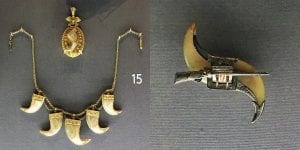Catch a Tiger by the Tail
By Erin Anderson, WPAMC Class of 2020

A photograph of King George V’s 1911 hunting expedition to Nepal. Over the course of the ten-day hunt, the party killed thirty-nine tigers, eighteen rhinoceros, and four bears. The monarch was visiting South Asia to be coronated as Emperor of India, and the Maharaja of Nepal organized the hunting trip as a celebratory gift. Photograph courtesy of Daily Mail.
Once the sporting pastime of local rulers, tiger hunting became the hobby of British colonists in Imperial India, a logical progression from fox and stag hunting traditions in Britain. Firearm codes and the cost of labor and hunting equipment effectively limited the practice to wealthy Europeans who, in theory, followed chivalric rules of “fair” hunting to distinguish themselves from locals who hunted for sustenance and survival rather than sport. Tiger hunts quickly became a chance for colonists to flaunt their wealth by hosting large hunting entourages of both European and Indians. Hunters competed to kill the largest, most dangerous, and rarest animals. The pageantry and exhilarating danger of tiger hunts tended to draw in large crowds of spectators. Publicized accounts of tiger hunts became popular reading material, and improved photographic equipment with shorter exposure times, encouraged the market for staged photographs of hunters and their quarries.
Tigers and their signature stripes had historically been a symbol of regional Indian authorities, most famously of the Mysore Sultan Tipu (r. 1782-1799). Under imperial control, tiger hunting became a symbol of Britain’s dominance over native rulers. Contemporary artwork reflected this political ideology, depicting India as an untamed, ferocious, man-eating tiger and the British Empire as a white hunter or a lion (a reference to the English heraldic lion).

“The British Lion’s Vengeance on the Bengal Tiger,” Punch cartoon, 1857. Britons living in India were particularly concerned by the myth of the “man-eating” tiger, despite the fact that tiger attacks on humans were relatively rare. Human-tiger interactions increased as the British pushed deeper into forested areas constructing railroad and telegraph lines, expanding agricultural programs, and harvesting timbers. Ironically, some historians have argued that early European tiger hunters may have increased the number of “man-eating” tigers by wounding – but not killing – many tigers with their inferior firearms thus causing the cats to seek riskier prey like cattle and humans in desperation. Image in the public domain.
British audiences were familiar with these representations. They appeared frequently in popular magazines like Punch and in curiosities like the famous “Tipu’s Tiger,” an Indian-made mechanical organ in the form of a tiger mauling a British soldier looted from the treasury of Sultan Tipu following his 1799 death and defeat by the British.

Sometimes alternatively spelled as “Tippoo’s Tiger,” this mechanical organ was constructed for Sultan Tipu of Mysore, India c.1793. Turning the handle waves the victim’s arm up and down and allows the organ to be played. Tipu was killed by the British Army in the Siege of Seringapatam in 1799, at which point his treasury and art collection were dispersed. This organ went to the Indian Museum at the headquarters of the East India Company before subsequently being transferred to what would become the Victoria and Albert Museum where it remains on display today. Photograph courtesy Victoria and Albert Museum, London.
Victorians at home interacted with a wide range of exotic animals, including tigers, thanks to popular attractions like zoos, natural history collections, traveling menageries, and demonstrations like the Great Exhibition in 1851 where living and preserved specimens dazzled enormous crowds. The most wealthy and adventurous might patronize London’s more than one hundred exotic animal dealers. Victorians also reveled in the bounty of the British Empire and increasingly sought exotic souvenirs for their own homes.
Hunting trophies including pelts, taxidermy mounts, and accessories made from fur, claws, or teeth became popular commodities. Tiger claws mounted in costume jewelry became a consumer item for both men and women, particularly for Britons living in India.

Tiger claw jewelry on display at the Fashion Museum in Bath, England. Top left: Tiger claw pendant, 1880s; Lower left: Tiger claw necklace, 1880s; Right: Tiger claw brooch, 1870s, from the Hull Grundy Collection. Photographs by the author.
The Van Ingen & Van Ingen taxidermy firm in Mysore, India mounted an estimated 43,000 large cats in a fifty-year period, relying on their signature mold-based techniques and cheap, unskilled labor from the local population to complete the work. Taxidermy mounts frequently reflect the poses and ferocity of tigers as portrayed in prints: crouched and snarling with bared teeth. A good example is one of the thirty-nine tigers killed by King George V’s 1911 hunting expedition in Nepal, now housed in the Bristol Museum & Art Gallery.

One of thirty-nine tigers killed during King George V’s 1911, ten-day hunting expedition to Nepal. The specimen was subsequently mounted, placed in a diorama case painted by Stanley Lloyd, and donated to the Bristol Museum & Art Gallery. Experts estimate there are fewer than 2,500 tigers left in India today, and fewer than 4,000 in the entire world. Photograph courtesy of Bristol Museum & Art Gallery.
Ironically, it was the diminishing quality of hunting trophies that led Imperial Britain to undertake an aggressive conservation program to protect native tiger populations. Concerned with the disappearance of large, healthy tigers—considered the “worthiest” opponents—and the introduction of new weaponry which made hunting far easier, British rulers in India issued hunting licenses, imposed strict quotas, and passed the 1878 Indian Forest Act restricting the use of forested land, timber, and other natural resources.
Tigers remained a popular motif in art and design throughout the British Empire. They appeared in prints and paintings, books and printed ephemera, ceramics, jewelry, natural history collections and many other design forms as a symbol of India.

Leave a Reply